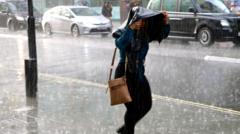Will Thunderstorms Bring Flash Flooding? Amber Warning Issued!

Understanding the Impacts of Flash Flooding in the UK: A Comprehensive Guide
As parts of the UK prepare for potentially dangerous flash flooding, it’s essential to understand the dynamics of such weather conditions. The recent amber weather warning issued by the Met Office serves as a reminder of how quickly weather can shift from oppressive heat to torrential rain, with significant implications for everyday life. This article delves into the causes of flash flooding, the potential consequences, and the necessary precautions to take during such weather events.
The Threat of Flash Flooding
Flash flooding is characterized by rapid onset and intense rainfall, often occurring within six hours of heavy precipitation. It’s particularly dangerous because it can lead to severe disruptions and pose a risk to life. In the context of the UK, the recent amber weather warning indicates that over a month's worth of rain could fall in just a few hours, leading to fast-flowing floodwaters that can inundate homes, disrupt transport, and cause power outages.
What Causes Flash Flooding?
Flash floods can occur for various reasons, but several key factors contribute to their development:
- Intense Rainfall: When heavy rain falls over a short period, the ground may not absorb water quickly enough.
- Dry Ground Conditions: Following extended dry spells, such as the recent heatwave, the ground becomes hard and less permeable, increasing surface runoff.
- Urbanization: In urban areas, impervious surfaces like roads and pavements prevent water absorption, exacerbating flooding.
- Topography: Areas with hills or slopes can direct water flow into lower-lying regions, intensifying flooding.
The Current Climate in the UK
The UK has recently experienced a third heatwave of the year, which has left the ground parched and unable to absorb moisture effectively. With the forecasted rainfall of 20 to 40mm within an hour, and potentially up to 100mm in just a few hours, the risk of flash flooding becomes even more pronounced. The combination of dry soil and heavy rain creates a scenario where water quickly runs off into local sewers and waterways, which may become overwhelmed.
Amber vs. Yellow Weather Warnings
The Met Office issues weather warnings to help residents prepare for severe conditions. The amber warning currently in effect signifies a higher likelihood of severe weather impacting daily life, including potential dangers to life. In contrast, yellow warnings indicate less severe weather but still warrant caution.
Impacts of Flash Flooding
Flash flooding can have a range of dire consequences for communities, infrastructure, and the environment. Here are some of the most significant impacts:
1. Property Damage
Flooding can lead to extensive damage to homes and businesses. Rapidly rising water can infiltrate buildings, damaging electrical systems, flooring, and personal belongings. The cost of repairs can be substantial, leading to financial strain for affected families and business owners.
2. Disruption of Transport
As floodwaters rise, roads can become impassable, leading to significant transport disruptions. Public transport systems, including buses and trains, may face cancellations or delays, affecting commuters and travelers alike. This disruption can lead to economic impacts, as businesses may struggle to operate efficiently.
3. Risk to Life
Perhaps the most concerning aspect of flash flooding is the threat it poses to human life. Fast-flowing waters can sweep away vehicles and individuals, leading to serious injuries or fatalities. It’s crucial for residents to heed warnings and take necessary precautions to ensure their safety.
4. Environmental Consequences
Flooding can lead to soil erosion, water contamination, and damage to ecosystems. The sudden influx of water can wash away topsoil, harming agricultural productivity and impacting local wildlife habitats. Additionally, floodwaters may carry pollutants, further degrading water quality in affected areas.
Preparing for Flash Flooding
Preparation is key to minimizing the impacts of flash flooding. Here are several steps you can take to ensure your safety and mitigate potential damage:
1. Stay Informed
Regularly check weather updates from reliable sources such as the Met Office. Understanding the severity of warnings and predictions can help you prepare adequately.
2. Create an Emergency Plan
Having a well-defined emergency plan can save lives. This plan should include:
- A designated meeting place for family members.
- Emergency contact numbers.
- A communication plan to stay in touch during a flood event.
3. Assemble an Emergency Kit
Your emergency kit should include essential supplies such as:
- Water and non-perishable food.
- First aid supplies.
- Flashlights and batteries.
- A portable phone charger.
4. Know Your Risk
Understanding whether you live in a flood-prone area can help you assess your risk. Local government websites often provide information about flood history and risk levels.
5. Protect Your Property
Consider taking preventive measures for your home, such as:
- Installing flood barriers or sandbags.
- Elevating electrical systems and utilities.
- Clearing gutters and drains to facilitate proper drainage.
What to Do During a Flash Flood
In the event of a flash flood, your safety should be the top priority. Here are steps to take:
1. Move to Higher Ground
If you are in a flood-prone area, evacuate to higher ground immediately. Avoid walking or driving through floodwaters, as even shallow water can be dangerous.
2. Listen to Authorities
Follow instructions from local authorities and emergency services. They provide critical information on evacuation routes and safety measures.
3. Stay Indoors if Safe
If you are already in a safe location, stay indoors until the flooding subsides. Monitor updates through your phone or radio.
After the Flood: Recovery and Support
The aftermath of flash flooding often leaves communities in need of recovery and support. Here are some considerations for the recovery phase:
1. Assess Damage
Once it is safe to do so, assess the damage to your property. Take photographs for insurance claims, and document any losses.
2. Seek Assistance
Reach out to local authorities or disaster relief organizations for assistance. They may provide resources for recovery, such as financial aid or temporary housing.
3. Clean Up Safely
When cleaning up after a flood, prioritize safety. Wear protective gear, such as gloves and masks, and ensure that electrical systems are safe before entering affected areas.
4. Mental Health Support
Experiencing a flood can be traumatic. Consider seeking mental health support if you or your family members are struggling with anxiety or distress related to the event.
Frequently Asked Questions (FAQs)
What should I do if I receive an amber weather warning?
If you receive an amber weather warning, it is crucial to stay informed and prepared. Monitor local weather updates, have an emergency plan in place, and take necessary precautions to protect your property and ensure your safety.
How can I protect my home from flooding?
You can protect your home from flooding by installing flood barriers, elevating electrical systems, and clearing gutters and drains. Additionally, consider using sandbags to redirect water away from your property.
What are the signs of flash flooding?
Signs of flash flooding include heavy rain, rapidly rising water levels, and debris flow. If you notice these indicators, seek higher ground immediately.
Conclusion
Flash flooding presents significant risks and challenges for communities across the UK. Understanding the causes, impacts, and preparation strategies can make a critical difference in mitigating these dangers. As the weather continues to shift, being proactive and informed will help keep you and your loved ones safe during extreme weather events.
How prepared are you for the next weather emergency? It’s time to take action and ensure your safety and well-being. #FlashFlooding #WeatherPreparedness #UKWeather
Published: 2025-07-18 18:35:05 | Category: technology



